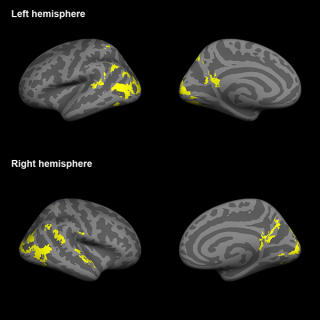Neuromarketing reveals what you think of a brand
PhD candidate Hang-Yee Chan from the Erasmus Research Institute of Management (ERIM) used SURF’s HPC Cloud to analyze neuroimaging data. He collected the data when volunteers watched brand logos inside an MRI scanner. “We were able to map out the connection between consumers' brain responses to brand logos and their opinions on those brands.”
Chan and his team extracted neural pattern responses when individuals watched different brand logos, and decoded these neural patterns against a range of brain activity templates they recorded in a separate session. “We were able to see, for example, that family brands such as Disney elicited neural responses similar to those of individuals watching photos of families. Moreover, using this information, we were able to predict above chance whether a given pair of brands would be perceived as compatible for commercial collaboration (i.e. making cobranding products).”
A more accurate sentiment
“In essence, our efforts to extract and decode information from neural signals bring us closer to learning how a consumer's brain reacts to the marketing that's all around us, and how a consumer feels towards a particular brand. There is a lot of inaccuracy in self-report studies. Neuromarketing helps us to obtain a more accurate sentiment. By studying in which parts of the brain we see activity, we try to read what is on the consumer’s mind. We don’t actually read their thoughts of course, but the neuroimaging data reveal clues to their state of mind, so to speak. Potentially, this could be used by marketing companies. But the technique has still to be refined.”
Easily accessible platform
Chan heard about SURF from the IT team at Erasmus University. He already had experience working in the cloud: he was using Amazon cloud services, but the cost was starting to be a concern. Furthermore, Amazon doesn’t offer the technical support and consultancy that SURF offers. The HPC Cloud team helped Chan set up an accessible platform for his research group and his supervisor that is easy to use, regardless of their previous experience working with cloud computing.
HPC Cloud enables users to fully control the computing environment they are working in. This applies to both the operating system and the analysis software. Researchers can set up a user interface and make the virtual machines (VMs) in the cloud available to their colleagues. Chan: “HPC Cloud is convenient for collaboration. Besides the HPC Cloud, we use the SURF Archive to back-up the data files in a safe place. And SURFdrive is useful for exchanging analysis scripts and data files with team members.”

This image shows brain areas (in yellow) from which activity patterns are extracted in order to understand how individuals feel towards a brand logo.
Quickly analyzing a lot of data
“We used SURF’s HPC Cloud to analyze neuroimaging data we collected when volunteers watched brand logos inside the MRI scanner. We apply machine learning algorithms to uncover neural patterns. This involves a lot of data. Thanks to the HPC Cloud service, we have been able to analyze these quickly. We obtain brain scans for about 1 hour from one participant, which amounts to around 1 gigabyte of data. For this study, we used 40 people, so that´s basically 40 gigabytes of data. I could still run that on a desktop computer, but it would take a lot of time. It’s also a very iterative process, where I try different approaches and different kinds of optimizations. That would not be feasible on a normal desktop.”
Responsibly using resources
The HPC Cloud is one of the most flexible services offered by SURF: the researcher has full control of their virtual machines. But with this flexibility comes the price of responsibility. Not all researchers are conscious of the fact that their VMs in the HPC Cloud continue to consume resources after the calculations are finished. This is especially true in the HPC Cloud service where CPU and memory allocations are often close to the maximum available resources. In practice this results in longer waiting times for other researchers to spawn new VM instances and pursue their research goals. Having used a commercial service like Amazon before, Chan was mindful of this: “It’s good to be aware that the minute you shut down your VM, you are releasing resources to others.”
More information
H.Y. Chan, M.A.S. Boksem & A. Smidts (2018). Neural profiling of brands: Mapping brand image in consumers' brains with visual templates. Journal of Marketing Research, 55 (4), 600-615. doi: 10.1509/jmr.17.0019
